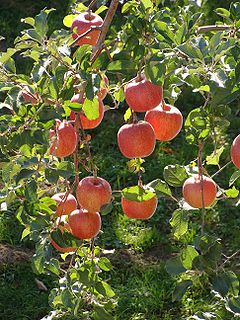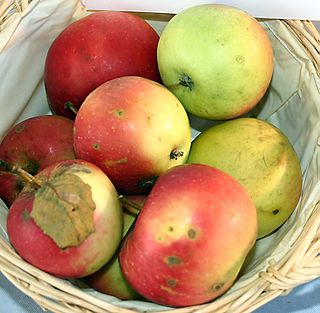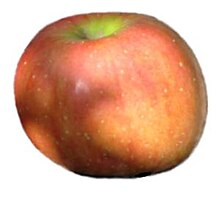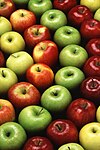
The McIntosh, McIntosh Red, or colloquially the Mac is an apple cultivar, the national apple of Canada. The fruit has red and green skin, a tart flavour, and tender white flesh, which ripens in late September. In the 20th century it was the most popular cultivar in Eastern Canada and New England, and is considered an all-purpose apple, suitable both for cooking and eating raw. Apple Inc. employee Jef Raskin named the Macintosh line of personal computers after the fruit.

'Golden Delicious' is a yellow apple, one of the 15 most popular cultivars in the United States. It is not closely related to 'Red Delicious'.

The Granny Smith is a tip-bearing apple cultivar which originated in Australia in 1868. It is named after Maria Ann Smith, who propagated the cultivar from a chance seedling. The tree is thought to be a hybrid of Malus sylvestris, the European wild apple, with the domesticated apple Malus pumila as the polleniser.
Cider apples are a group of apple cultivars grown for their use in the production of cider. Cider apples are distinguished from "cookers" and "eaters", or dessert apples, by their bitterness or dryness of flavour, qualities which make the fruit unpalatable but can be useful in cidermaking. Some apples are considered to occupy more than one category.

The 'Red Delicious' is a clone of apple cultigen, now comprising more than 50 cultivars, first recognized in Madison County, Iowa, in 1880. It is one of the fifteen most popular apple cultivars in the United States. From 1968 to 2018, it was the most produced cultivar in the U.S.

Malus domestica is a cultivar of apple that is usually eaten cooked due to its sourness. The variety comes from a pip planted by Mary Ann Brailsford. The Concise Household Encyclopedia states, "Some people eat this apple raw in order to cleanse the palate, but Bramley's seedling is essentially the fruit for tart, pie, or dumpling." Once cooked, however, it has a lighter flavour. A peculiarity of the variety is that when cooked it becomes golden and fluffy.

The Fuji apple is an apple cultivar developed by growers at Tohoku Research Station (農林省園芸試験場東北支場) in Fujisaki, Aomori, Japan, in the late 1930s, and brought to market in 1962. It originated as a cross between two American apple varieties—the Red Delicious and old Virginia Ralls Genet apples. According to the US Apple Association website it is one of the fifteen most popular apple cultivars in the United States. Its name is derived from the first part of the town where it was developed: Fujisaki.

Gala is a clonally propagated apple cultivar with a mild and sweet flavour. In 2018, it surpassed Red Delicious as the apple cultivar with the highest production in the United States, according to the US Apple Association. It was the first time in over 50 years that any cultivar was produced more than Red Delicious.

Honeycrisp is an apple cultivar developed at the Minnesota Agricultural Experiment Station's Horticultural Research Center at the University of Minnesota, Twin Cities. Designated in 1974 with the MN 1711 test designation, patented in 1988, and released in 1991, the Honeycrisp, once slated to be discarded, has rapidly become a prized commercial commodity, as its sweetness, firmness, and tartness make it an ideal apple for eating raw. "...The apple wasn't bred to grow, store or ship well. It was bred for taste: crisp, with balanced sweetness and acidity." It has larger cells than most apple cultivars, a trait which is correlated with juiciness, as theoretically a higher number of cells rupture when bitten releases more juice in the mouth. The Honeycrisp also retains its pigment well and has a relatively long shelf life when stored in cool, dry conditions. Pepin Heights Orchards delivered the first Honeycrisp apples to grocery stores in 1997. The name Honeycrisp was trademarked by the University of Minnesota, but university officials were unsure of its protection status in 2007. It is now the official state fruit of Minnesota.

The 'Roxbury Russet' is an apple cultivar, believed to be the oldest apple cultivar bred in the United States, having first been discovered and named in the mid-17th century in the former Town of Roxbury, part of the Massachusetts Bay Colony southwest of Boston. It is known by several other names including 'Boston Russet', 'Putnam Russet', and 'Sylvan Russet'.

The Ben Davis is an apple cultivar.

The Jonathan apple is a medium-sized sweet apple, with a touch of acid and a tough but smooth skin. It is closely related to the Esopus Spitzenburg apple, good for eating fresh and for cooking.

'Ambrosia' is a cultivar of apple originating in British Columbia in the early 1990s. The original tree was first cultivated by the Mennell family of Similkameen Valley, British Columbia, who discovered it growing in their orchard.

The 'Rhode Island Greening' is an American apple variety and the official fruit of the state of Rhode Island.
The "Taliaferro", "Robinson" or "Robertson" was a small-sized apple grown at Monticello by Thomas Jefferson. This cultivar appears to be extinct, though some horticulturalists assert that the 'Highland County' cultivar may be related, or even the same cultivar under a different name.

The Zestar! apple or Minnewashta (cultivar) is an apple cultivar released in 1999. It was developed by the horticulturalists at the Minnesota Landscape Arboretum's Horticultural Resource Center, at the University of Minnesota.

The Wealthy is an American apple cultivar, and was the earliest to thrive in the Minnesota climate. Horticulturalist Peter Gideon first grew it in 1868, after years of trial and error with various apple varieties.

The Kentville Research and Development Centre (formerly Atlantic Food and Horticulture Research Centre) is a branch of Agriculture and Agri-Food Canada's national network of 20 research centres stationed across Canada. The site is situated on 464 acres in Kentville, located in Nova Scotia's Annapolis Valley. The Centre's programs address agricultural challenges throughout the Canadian horticultural and food network, but primarily focus on the regional requirements of Atlantic Canada. On September 2, 2003, the centre's staff was recognized by Environment Canada for providing a volunteer climate observation station for a continuous 70 years. On January 26, 2011, and in honour of their centennial celebration, the centre was bestowed with an honorary membership to the Nova Scotia Fruit Growers Association in recognition of the centre's development and support of a sustainable tree fruit industry in Atlantic Canada.

Autumn Glory is an apple cultivar developed by Domex Superfresh Growers, which is based in Washington (state). The fruit is marketed as Autumn Glory. The fruit, which has cinnamon tasting notes, is grown by Domex Superfresh Growers with a production of about 56,000 trees as of November 2014. Autumn Glory apples have a very sweet, firm flesh with hints of cinnamon and subtle notes of caramel. After being in development for a decade, the apple was released in the 2011 season. The Autumn Glory variety is a hybrid of the Fuji (apple) and Golden Delicious apple with a red coloring on a yellow background. The original pollination cross breed was made by Dr. Yu Lin Wang in 1976. It is picked in mid- to late-October of each year.




















